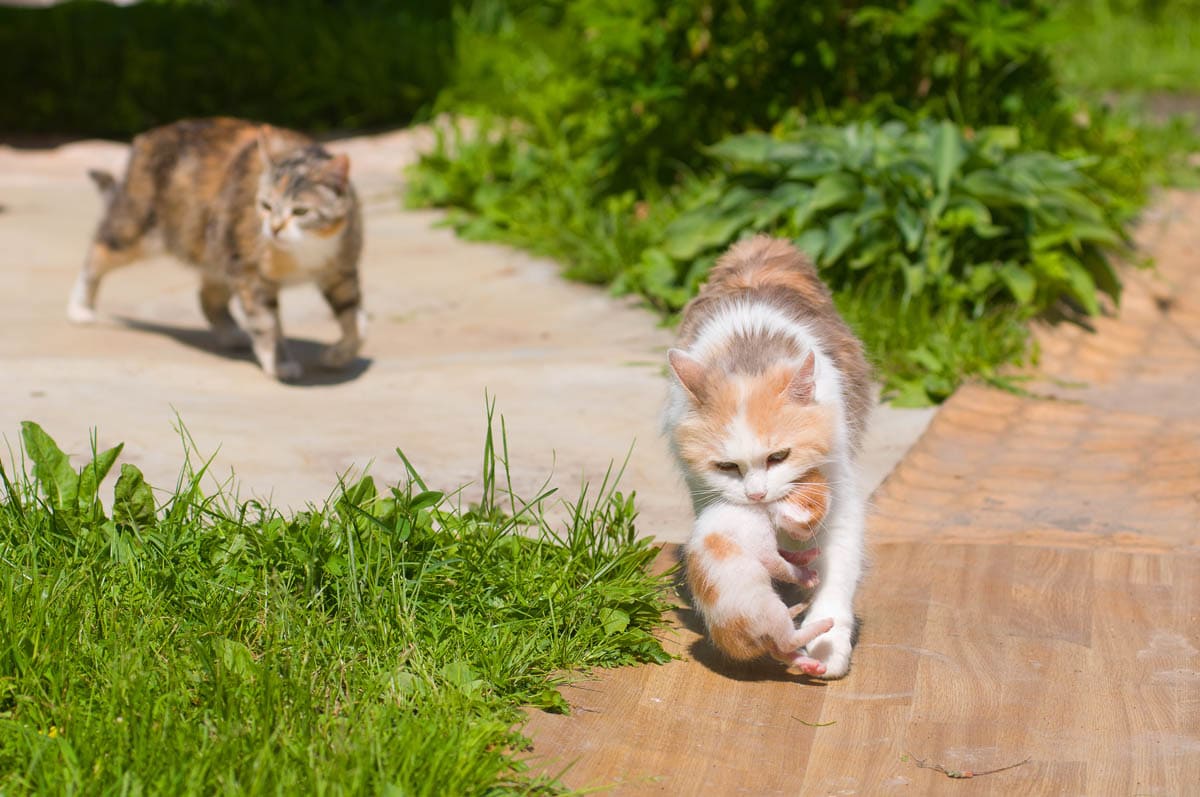Kittens are altricial, which means they are extremely immature and helpless for the first few weeks of life, unlike a horse who is precocial, which means they are born in an advanced state and can walk soon after birth. Altrical species are completely reliant on their mother and unable to protect themselves from danger. This vulnerability means a safe nest is essential for the safety of the kittens.
Many pet owners will choose a nest for their cat if she is pregnant. Others may move a cat and her kittens if she has set up a nest in an unsuitable place. But, what we choose may not be what the queen is happy with.
Why do mother cats move their kittens?
The queen’s job is to care for her kittens and keep them safe. If she feels she and her kittens are insecure she will move them.
Unhappy with the type or location of the nest
If the cat’s family have provided a nest, the queen may not be happy with the location or type of nest. This may be because of its location, materials used, temperature or even lighting. We may think a nest in the lounge room is a great idea, but the queen is more likely to choose a nest in a drawer or the back of a wardrobe.
Too many visitors
Disruptions include too much human or animal interference (children, a household pet visiting the nest or an over-zealous adult). Some queens will be comfortable with their human family visiting the nest, but others prefer privacy, and if they feel exposed, they will relocate the kittens to a new nest.
Soiled nest
During the birth, the queen keeps the nest clean by eating the placentas and cleaning her kittens; however, some soiling will occur. The queen may move her kittens to another nest in the days after giving birth to avoid attracting predators to a soiled nest.
Outgrowing the nest
Kittens grow at a rapid rate, doubling in the first week of life and by the fourth week, they will be five times their birth weight. The queen may relocate her kittens to a larger nest as the kittens outgrow the one they were born in.
Wandering too far
As the kittens mature, they will start to explore their environment, if the queen feels they are escaping the nest too soon or wandering too far, she may relocate them to a more secure nest to keep them contained.
How to help

Supervise but don’t intrude
Most queens are great mothers who know how to care for their kittens and in most cases, will not need help from humans other than food, water, litter trays and blankets. Checking on the mother and her kittens once a day is a good idea to make sure everybody is happy and well. However; the privacy of the mother and her kittens must be respected at all times. Let her be the guide, if she appears uncomfortable, back off. Keep children and family pets away from the cat in the first few weeks unless she is particularly bonded to another cat in the house and you are confident the kittens won’t be harmed.
Socialising kittens
For the first two weeks, kittens eat, sleep and do very little else. After three weeks, some kittens will start to explore.
Human interaction with kittens is vital for their socialisation; the socialisation window is from 2-6 weeks. During this critical period, kittens are most receptive to a wide range of stimuli which can lay down the groundwork for how the kitten responds to people and situations for the rest of his or her life. Begin this process slowly and always be aware of the mother cat’s comfort level if she is not happy, back off and try in a day or so. Keep kittens within sight of the mother when you are holding them.
Setting up a nest
If you have a cat who is expecting a litter of kittens, plan ahead as to the location and type of nest you will provide. It should be in a quiet part of the house which is free of drafts and is private.
Provide a nest that is easy to clean (or replace). Line the bottom of the nest with a 1-inch layer of old newspaper and place blankets on top. A day or so after the mother has given birth, remove the soiled blankets and replace them with fresh ones.
What should you do if you find a nest of kittens without their mother?
Do not disturb the nest, unless the kittens are in immediate danger. Watch from a safe distance to see if the mother cat returns. The chances are, she is hunting close to her kittens. If she returns to find a human nearby, she may wait until the coast is clear. Remember, she wants to protect her kittens, and by entering the nest while you are watching, she is showing the location of the nest and exposing her kittens to danger.
A nest of kittens who are being cared for by their mother should be clean and content. If they have been abandoned by the mother cat or a person, they may appear dirty, unkempt and hungry.

